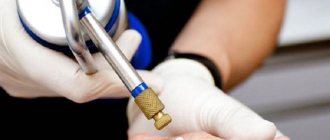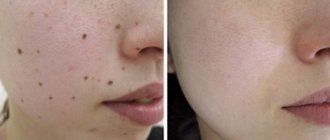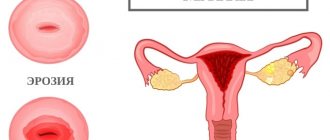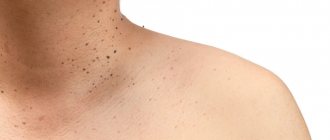- home
- / Blog
- / Electrocoagulation or laser - which is better for removing moles
Electrocoagulation and laser coagulation are popular methods for removing neoplasms (moles, warts, papillomas, condylomas). Electrocoagulation uses electric current. This technology has been used for more than 50 years. Laser is a more modern method. It acts in a targeted manner, burning only the part to be removed, without affecting adjacent, healthy tissue. In both cases, after removal, a crust forms, which itself falls off after healing. The site of treatment is distinguished by a lighter skin tone. When choosing which is better, electrocoagulation or laser, you need to know the positive and negative sides of the options.
What is laser coagulation
Laser coagulation is a modern method that solves the following cosmetic problems:
- removal of unwanted hair;
- removal of tumors;
- removal of age spots, freckles;
- removal of rosacea;
- removal of stars and small vessels;
- tattoo removal.
For varicose veins, the laser scleroses the walls of blood vessels, stopping bleeding without injuring it. Laser technology is precise and painless and is used to remove the following tumors: nevi, fibromas, hemangiomas, papillomas, papillomas, warts, moles, etc. Application is possible on any part of the body.
Removal of neoplasms by electrocoagulation
General provisions
1.1.
This Policy regarding the processing of personal data (hereinafter referred to as the Policy) is drawn up in accordance with paragraph 2 of Article 18.1 of the Federal Law “On Personal Data” No. 152-FZ of July 27, 2006, as well as other regulatory legal acts of the Russian Federation in the field of protection and processing of personal data and applies to all personal data (hereinafter referred to as the Data) that Eva LLC (hereinafter referred to as the Operator, the Company) can receive from the subject of personal data who is a user of the site (hereinafter referred to as the User) located at the address on the network Internet https://www.evamedic.ru/ (hereinafter referred to as the Site). 1.2. The operator ensures the protection of processed personal data from unauthorized access and disclosure, misuse or loss in accordance with the requirements of the Federal Law of July 27, 2006 No. 152-FZ “On Personal Data”.
1.3. Change of Policy.
1.3.1. The operator has the right to make changes to this Policy. When changes are made, the date of the last update of the edition is indicated in the title of the Policy. The new edition of the Policy comes into force from the moment it is posted on the Site, unless otherwise provided by the new edition of the Policy.
Terms and accepted abbreviations
Personal data (PD) - any information relating to a directly or indirectly identified or identifiable individual (subject of personal data).
Processing of personal data - any action (operation) or set of actions (operations) performed using automation tools or without the use of such tools with personal data, including collection, recording, systematization, accumulation, storage, clarification (updating, changing), extraction, use, transfer, depersonalization, blocking, deletion, destruction of personal data.
Automated processing of personal data - processing of personal data using computer technology.
Personal data information system (PDIS) is a set of personal data contained in databases and information technologies and technical means that ensure their processing.
Personal data made publicly available by the subject of personal data - PD, access to an unlimited number of persons is provided by the subject of personal data or at his request.
Blocking of personal data is a temporary cessation of processing of personal data (except for cases where processing is necessary to clarify personal data).
Destruction of personal data - actions as a result of which it becomes impossible to restore the content of personal data in the personal data information system and (or) as a result of which material media of personal data are destroyed.
Operator is an organization that, independently or jointly with other persons, organizes the processing of personal data, as well as determines the purposes of processing personal data to be processed, actions (operations) performed with personal data. The operator is Eva LLC, location: 654027, Kemerovo region, Novokuznetsk, st. Suvorova, house No. 6, room 45, OGRN 1144217007615, TIN 4217166873.
Processing of personal data
3.1. Receiving PD.
3.1.1. All PD should be obtained from the subject himself. If the subject's PD can only be obtained from a third party, then the subject must be notified of this or consent must be obtained from him.
3.1.2. The operator must inform the subject about the purposes, intended sources and methods of obtaining PD, the nature of the PD to be received, the list of actions with PD, the period during which the consent is valid and the procedure for its revocation, as well as the consequences of the subject’s refusal to give written consent to receive it.
3.1.3. PD is transferred by the subject for processing by the Operator by:
- visiting the Site by the User;
- filling out the feedback form on the Site by the User (request a call, leave a review, register, place an order, etc.).
3.2. PD processing.
3.2.1. Processing of personal data is carried out:
- with the consent of the subject of personal data to the processing of his personal data;
- in cases where the processing of personal data is necessary for the implementation and fulfillment of the functions, powers and responsibilities assigned by the legislation of the Russian Federation;
- in cases where the processing of personal data is carried out, access to an unlimited number of persons is provided by the subject of personal data or at his request (hereinafter referred to as personal data made publicly available by the subject of personal data).
3.2.2. Purposes of processing personal data:
- increasing awareness of Site users about the Company's products/works/services, providing relevant advertising information, optimizing advertising, providing information support, consulting, conducting marketing campaigns (including email newsletters and SMS notifications about news and promotions, etc. .), sending notifications about the status of requests, requests, orders, as well as in other cases of use of the Site by the User.
3.2.3. Categories of personal data subjects.
The PD of the following PD subjects is processed:
- individuals - Site Users.
3.2.4. PD processed by the Operator:
- last name, first name, patronymic of an individual and/or individual entrepreneur, position held, email address, contact phone number, location address;
- source of access to the Site and information from the search or advertising request;
- data about the user device (including resolution, version and other attributes characterizing the user device);
- user clicks, page views, field completions, impressions and views of banners and videos;
- data characterizing audience segments;
- session parameters;
- information about the time of visit;
- information stored in cookies
- IP address.
3.2.5. Personal data is processed:
- using automation tools;
- without the use of automation tools.
3.3. PD storage.
3.3.1. PD of subjects received by the Operator undergoes further processing and is transferred for storage in electronic form.
3.3.2. It is not allowed to store and place documents containing personal data in open electronic catalogs (file sharing services) in ISPD.
3.3.3. PD is stored in a form that makes it possible to identify the PD subject for no longer than required by the purposes of their processing, and they are subject to destruction upon achievement of the purposes of processing or in the event of the loss of the need to achieve them.
3.4. Destruction of PD.
3.4.1. PD on electronic media is destroyed by erasing or formatting the media.
3.4.2. The fact of destruction of PD is documented by an act of destruction of media.
3.5. Transfer of PD.
3.5.1. The operator transfers PD to third parties in the following cases:
- the subject has expressed his consent to such actions;
- the transfer is provided for by Russian or other applicable legislation within the framework of the procedure established by law.
Protection of personal information
4.1. The main PD protection measures used by the Operator are:
4.1.1. Appointment of a person responsible for PD processing, who organizes PD processing, training and instruction, internal control over compliance by the Operator and its employees with PD protection requirements.
4.1.2. Identification of current threats to the security of personal data when processing them in ISPD and the development of measures and measures to protect personal data.
4.1.3. Development of a policy regarding the processing of personal data.
4.1.4. Establishment of rules for access to personal data processed in ISPD.
4.1.5. Setting access passwords for the Operator's employees in the ISPD.
4.1.6. Compliance with conditions ensuring the safety of personal data and excluding unauthorized access to them.
4.1.7. Detection of facts of unauthorized access to personal data and taking measures.
4.1.8. Restoration of personal data modified or destroyed due to unauthorized access to it.
4.1.9. Training of the Operator's employees directly involved in the processing of personal data in the provisions of the legislation of the Russian Federation on personal data, including requirements for the protection of personal data, documents defining the Operator's policy regarding the processing of personal data, local regulations on the processing of personal data.
4.1.10. Implementation of internal control and audit.
Basic rights of the subject of personal data and obligations of the Operator
5.1. Basic rights of the subject of personal data.
The subject has the right to access his personal data and the following information:
- confirmation of the fact of processing of PD by the Operator;
- legal grounds and purposes of PD processing;
- the purposes and methods of PD processing used by the Operator;
- name and location of the Operator, information about persons (except for the Operator’s employees) who have access to PD or to whom PD may be disclosed on the basis of an agreement with the Operator or on the basis of federal law;
- terms of processing of personal data, including periods of their storage;
- the procedure for the exercise by the subject of personal data of the rights provided for by the Federal Law of July 27, 2006 No. 152-FZ “On Personal Data”;
- name or surname, first name, patronymic and address of the person processing PD on behalf of the Operator, if the processing has been or will be assigned to such a person;
- contacting the Operator and sending him requests;
- appealing the actions or inaction of the Operator.
5.2. Responsibilities of the Operator.
The operator is obliged:
- when collecting PD, provide information about PD processing;
- in cases where the PD was not received from the subject of the PD, notify the subject;
- in case of refusal to provide PD, the consequences of such refusal are explained to the subject;
- publish or otherwise provide unrestricted access to a document defining its policy regarding the processing of personal data, to information about the implemented requirements for the protection of personal data;
- take the necessary legal, organizational and technical measures or ensure their adoption to protect PD from unauthorized or accidental access to it, destruction, modification, blocking, copying, provision, distribution of PD, as well as from other unlawful actions in relation to PD;
- provide responses to requests and appeals from subjects of personal data, their representatives and the authorized body for the protection of the rights of subjects of personal data.
Advantages of the methods
Advantages of laser tumor removal:
- the procedure is painless;
- not accompanied by bleeding;
- minimal risk of complications;
- short rehabilitation period.
Before carrying out the laser coagulation procedure, you must consult your doctor and become familiar with the contraindications.
After the procedure, you should not visit the sauna or bathhouse, do not take a hot bath, and you must refrain from being in the open sun. Before going outside, you should use sunscreen with an ultraviolet protection factor of SPF 50+. Electrocoagulation is carried out using a special electrocoagulator apparatus. Various new growths are cauterized without damaging the healthy tissue around them using current.
How to remove a wart on the hands or a plantar wart?
How to get rid of warts without harming your health is a question that has been asked for hundreds of years. The remedy for warts, as well as for papillomas, is celandine. Celandine is the simplest remedy for warts. In order for the removal of warts on the hands or plantar warts to be successful, it is enough to cauterize the location of the warts on the hands or feet with the secreted juice of celandine a couple of times a day for a month. Salicylic acid is also a remedy for hand warts and plantar warts. It softens the tumor tissue and irritates it, which leads to its disappearance. Castor oil is also a remedy for warts on the hands. Dandelion or milkweed juice is widely used not only for treatment, but also as a remedy for warts on the hands and plantar warts. This remedy for warts may not get rid of the problem, but at least it will not worsen the situation.
Electrocoagulation technology remains the highest quality and most effective remedy for warts and papillomas.
It is known how to get rid of warts and papillomas using folk remedies, but to remove moles , you need to turn to cosmetology.
Professional cosmetology has long been using electrocoagulation technology.
How is the procedure performed?
After the procedure, the cauterization site heals under a dry crust, which must be treated with antiseptics for the first few days. The main advantages of electrocoagulation:
- removal of tumors;
- does not cause bleeding;
- the risk of infection is eliminated;
- does not require hospitalization;
- It is possible to carry out the procedure on all parts of the body.
Recommendations for preparing for the coagulation procedure:
- within two weeks it is necessary to avoid taking antibiotics;
- do not sunbathe in the open sun;
- Do not use products containing alcohol.
To decide to remove tumors, you need to consult a dermatologist who will select a more appropriate coagulation method.
In what cases is electrocoagulation technology used?
An electrocoagulation session is used to remove warts, remove moles on the face, remove papillomas and plantar warts. Unfortunately, it is quite rare to turn to a cosmetologist to solve these problems, although this method has long been used in professional facial cosmetology.
People come to a cosmetologist only when all the remedies at home have been tried, but they have not helped or have worsened the situation. Another reason for visiting a cosmetology center is discomfort from the presence of papillomas or moles on the face.
Now let's talk about the most common types of skin tumors.
When a person is born, he does not have a single mole on his face or body. They usually appear before age 25. You cannot remove a mole yourself; it is extremely dangerous to your health. Removal of moles on the face or body should be carried out by a cosmetologist who has a special education; under no circumstances seek the services of medical professionals who do not have the necessary knowledge, skills and experience. If a mole is removed incorrectly, the development of melanoma can be stimulated. If a mole on the face or body is benign, electrocoagulation of the mole can be done. Electrocoagulation of a mole is considered to prevent the appearance of melanoma. The condition of the tumors must be constantly monitored. Suspicious moles on the face or other part of the body are considered if they: appeared in adulthood, the surface became glossy, asymmetry appeared, began to bleed, are larger than one centimeter in size, or change over time. In such cases, you need to contact an oncologist. The mole removal procedure should only be performed after consultation with an oncologist or dermatologist.
Warts can occur when a person sweats excessively; in this case, warts appear on the hands and feet (plantar wart). A plantar wart can occur due to tight shoes, unlike a simple plantar wart, a plantar wart interferes with walking due to the high degree of pain. Scratches and cuts can also be the cause. Warts on the hands usually appear between the fingers and on the back of the hand. If you do not remove the wart immediately, then after a while you will have to deal with the removal of much larger numbers of warts.
Papilloma is similar to the previous neoplasm, only it has a stalk. It has an uneven surface. The color of papilloma can vary: from white to brown. Papilloma causes discomfort in the form of itching. Papilloma can also bleed. You can protect yourself from neoplasms in the form of papillomas if you don’t succumb to stress, have a strong immune system, and be sure to treat cuts and scratches with disinfectants. The occurrence of papillomas and warts on the hands indicates a low level of the body's immune defense. Often the appearance of papillomas is associated with disorders in the intestinal tract and metabolic disorders. Advanced forms of colitis, kidney disease, gynecological diseases and gastritis stimulate the formation of papilloma. Removing papillomas, as well as removing warts, is dangerous to do on your own. By cutting and tearing out papillomas, you increase the risk of infection in the body.
small papilloma using folk remedies The simplest methods for treating papilloma are celandine or dandelion juice. To remove papilloma, it is enough to lubricate the papilloma with the juice of these plants until it completely disappears. Castor oil and ammonia are also suitable for treating papilloma.
Symptoms that require you to consult a dermatovenerologist:
- change in color, shape of formation
- a sharp increase in the size of the formation and/or the appearance of new formations
- the occurrence of subjective sensations in the field of education (pain, itching)
- bleeding formation
- the appearance of purulent discharge in the area of formation
- significant increase in the number of formations
The method and tactics of treatment must be determined by a dermatovenerologist! Prescribe therapeutic treatment, if necessary, conduct electrocoagulation of the formation!
A dermatovenerologist conducts differential diagnostics; if necessary, consultation with an oncologist is required.
What is this procedure?
One of the highly effective treatment procedures is electrocoagulation of vascular networks. Pathological vascular neoplasm is eliminated by cauterization or sealing of tissue altered by pathology. For these purposes, the use of high-frequency currents (direct or alternating) is implied.
The procedure is widely used not only in medicine, but also in cosmetology. Since it not only removes telangiectasia from the epidermis, but improves blood circulation and metabolism, which normalizes the condition of the skin.
Removal of vessels that have lost their elasticity by electrocoagulation has the following effects on the tissue:
- Biological.
During the procedure, simultaneous death of pathological tissue and stimulation of undamaged tissue occurs, followed by regeneration; - Physico-chemical.
Physico-chemical bonds that are responsible for the attraction of cells are destroyed; - Thermal.
Causes burns because living tissue is heated to a high temperature; - Electrodynamic.
Leads to a change in structure, i.e. rupture of cells and tissues under the action of steam generated by heating blood, interstitial and lymphatic fluid.
Expert opinion
Such a wide spectrum of action of electric current leads to the removal of blood from deformed capillaries and subsequent gluing of their walls. In this regard, such capillaries are excluded as a link from the microcirculatory bloodstream, and accordingly cease to participate in the blood flow. At the same time, the external condition of the skin takes on a healthy appearance - the vascular pattern disappears.
Vascular surgeon, phlebologist
Osipova Ekaterina Yakovlevna
Preparing to remove moles with an electric knife
Proper preparation is the key to the successful completion of every medical procedure. Cauterizing a nevus with an electric knife is no exception, but in most cases does not require special preparation. We prescribe tests before the procedure for removing a nevus using electrocoagulation if you have a history of heavy bleeding or there are doubts about the benignity of the mole. In the above situations you will need:
- Clinical blood test.
- Coagulogram (determination of blood clotting indicators).
- Blood test for tumor markers.
Since removal of moles with an electrocoagulator does not require general anesthesia, there is no need for a “fasting” regime on the eve of surgery.
Electrocoagulation or laser: which is better?
The laser technique for removing vascular formations is more modern than techniques such as electrocoagulation. And it has a large number of followers. But at the same time, electrocoagulation is an integral part of hardware cosmetology and medicine.
Expert opinion
Electrocoagulation is still not recommended for removing vascular formations on the skin of the face. Due to the lack of a guarantee that over time a scar, age spot or even a scar will not form. Laser therapy is preferable in this case, since healthy tissue cells are not damaged, and accordingly, the risk of undesirable consequences is reduced significantly.
Vascular surgeon, phlebologist
Osipova Ekaterina Yakovlevna
And yet, which is better? There is no clear answer. Both methods are highly effective and widely used. The choice of method for removing spider veins remains with the attending physician. In turn, it is worth noting that electrocoagulation is considered a more universal, simple and affordable way to remove capillary patterns.
Advantages and disadvantages of the procedure
Among the advantages of removing papillomas using electrocoagulation it is worth noting:
- high efficiency, safety, accessibility - several tumors can be removed in one session;
- the duration of removal of one papilloma is on average up to 5 minutes;
- the procedure is suitable for any skin type;
- the ability to control the depth and area of impact of the device;
- bloodless procedure, eliminating the possibility of infection;
- has a relatively low cost.
But if you choose the wrong strength, frequency and duration of electrical influence on the tumor, there is a risk of scarring and relapse. If you do not properly care for the damaged area after manipulation, there is a possibility of the formation of pigment spots.
Persons with highly sensitive skin will experience discomfort and pain for a long period of time. In total, healing time is 10 days. If compared with the laser - 5-7 days or the radio wave method - 2-3 days, then healing lasts a long time.
Contraindications
Before carrying out the manipulation, the dermatovenerologist must exclude the presence of contraindications in this patient and conduct an examination of the patient (if necessary).
These include:
- Blood clotting disorders.
- Individual intolerance to exposure to electric current.
- The presence of an active inflammatory process in the area of planned removal.
- Allergic reactions to local anesthetics (if the manipulation cannot be performed without pain relief).
- The presence of an active bacterial, viral, mycotic disease in the removal area.











